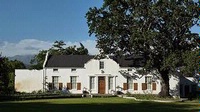Figuring out what the average American wine consumer wants is no more challenging than walking into Trader Joe’s or Costco and spending a few minutes in the wine department.
Wines from Chile and Argentina are prominent. Both countries are well-represented in the American wine market for good reason: Both are universally respected for the quality of their wines at reasonable prices.
 Yet this tried and true business model doesn’t work, or hasn’t worked, for everyone. The most glaring example is South Africa, which has been a serious wine-producing nation for at least three centuries.
Yet this tried and true business model doesn’t work, or hasn’t worked, for everyone. The most glaring example is South Africa, which has been a serious wine-producing nation for at least three centuries.
The wines of South Africa can be very, very good and are generally very, very cheap, owing to a currency exchange rate of 10 U.S. dollars for one South African rand. It would stand to reason, then, that South African wines would be every bit as attractive to the average American consumer as the wines of Chile and Argentina.
Yet that is not the case, a condition that longtime South African winemaker Niel Groenewald is at pains to reverse. Hence the chief winemaker for Bellingham Winery, established in 1693, recently made his first trip to the United States to put a genial face on the wines of South Africa.
This is an important step, it seems, because South African wines were shunned somewhat during the era of apartheid. Precious little has been done in the two decades since the end of apartheid to position South African wines to benefit from the sustained wine boom that has seen the United States emerge as the largest wine market in the world.
If South African wine is known for anything, it is typically the frequently disparaged red wine known as pinotage, made from a grape variety that is a cross between pinot noir and cinsault (which at one time was called hermitage in South Africa).
I am no fan, but had to concede the 2011 Bellingham "Bush Vine" pinotage ($30) Groenewald presented at lunch recently was a world class red, a meaty, smoky, firmly structured, complex wine that could stand as a benchmark for pinotage of a certain ilk.
"Because pinotage was a relatively new grape variety and only planted widely in the 1950s, there was no clear style that dictated what pinotage should be," he explained. "Stylistically it was all over the map."
The Groenewald expression of pinotage is clearly an attempt at classically structured red wine that will improve in the bottle for a decade or more.
"The best pinotage ages very well, even better than cabernet sauvignon in South Africa," he said.
The overall impression left by the Bellingham wines, including the independent brand Boschendal (established 1685), was positive. The wines are clean and well-balanced, with an emphasis on freshness. Chenin blanc is perhaps South Africa’s signature white wine, and the chenins of South Africa may well be the best chenins in the world outside of France.
But being good and cheap doesn’t in and of itself guarantee success in the market.That’s why the talented winemaker Groenewald is out on the wine stump spreading the word. It’s a small step, but a step nonetheless.
8
